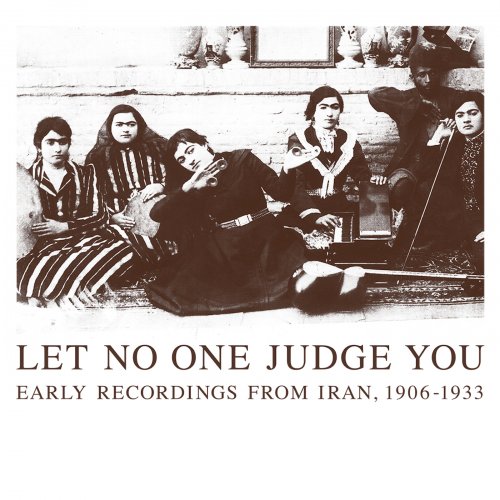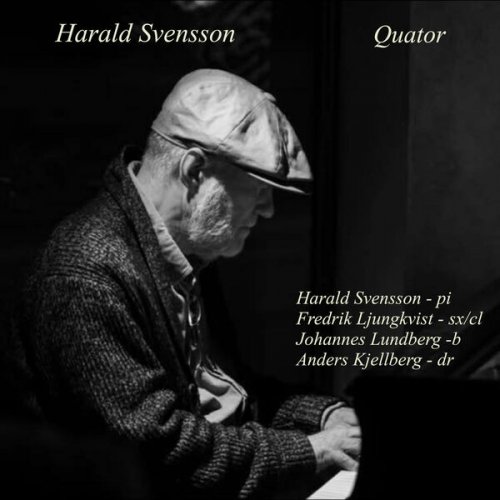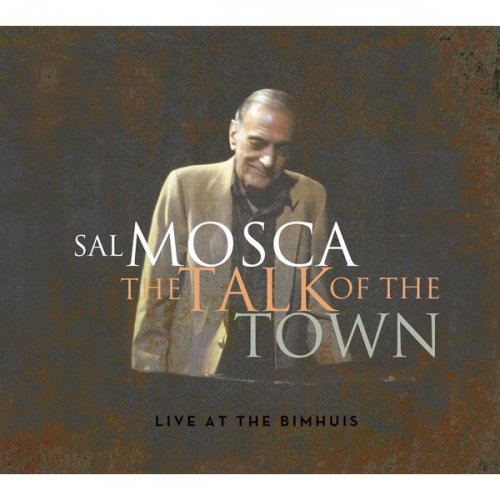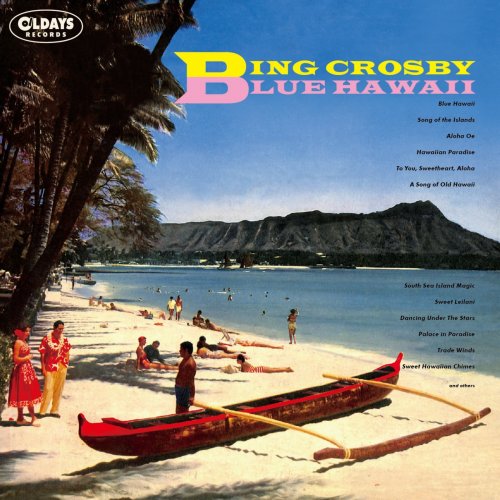VA - Let No One Judge You: Early Recordings from Iran, 1906-1933 (2014)

Artist: VA
Title: Let No One Judge You: Early Recordings from Iran, 1906-1933
Year Of Release: 2013
Label: Honest Jon's Records
Genre: Iranian Folk Music, Persian Classical Music
Quality: FLAC (tracks+.cue,log)
Total Time: 1:55:25
Total Size: 417 MB
WebSite: Album Preview
Tracklist:Title: Let No One Judge You: Early Recordings from Iran, 1906-1933
Year Of Release: 2013
Label: Honest Jon's Records
Genre: Iranian Folk Music, Persian Classical Music
Quality: FLAC (tracks+.cue,log)
Total Time: 1:55:25
Total Size: 417 MB
WebSite: Album Preview
CD1
1. Ebrāhim, Royal Orchestra - Bidād (Homāyun) (2:44)
2. Rezā-Qoli, Akbar - Gavri (Shur) (3:15)
3. Seyyed Hoseyn Tāherzādeh, Habibollāh Moshir-Homāyun - Bayāt Esfahān (Homāyun) (2:59)
4. Seyyed Hoseyn Tāherzādeh, Akbar - Darāmad (Homāyun) (3:13)
5. Not Known - Tār Solo (3:03)
6. Moluk Zarrābi - Darāmad, Dād (Mahur) (3:33)
7. Parvāneh - Mansuri (Chahārgāh) (3:35)
8. Parvāneh - Zābol, Mokhālef (Segāh) (3:52)
9. Abd-ol-Hoseyn Shahnāzi - Mokhālef (Segāh) (3:35)
10. Akhtar - Bayāt Esfahān, Bayāt Rāje’ (Homāyun) (3:48)
11. Javād Badi’zādeh - Morghe Bi-Āshiān, Afshāri (Shur) (3:30)
12. Irān od Dowleh Helen - Bidād (Homāyun) (3:29)
13. Moluk - Dashti (Shur) (3:22)
14. Montakhab-oz-Zākerin - Qafqāz I (Segāh) (3:35)
15. Montakhab-oz-Zākerin - Qafqāz II (Segāh) (3:34)
16. Abd-ol-Hoseyn Shahnāzi - Darāmad (Homāyun) (3:33)
17. Hayk - Shushtar (Homāyun) (3:39)
CD2
1. Qoli, Royal Orchestra - Abu-’Atā (Shur) (2:52)
2. Seyyed Hoseyn Tāherzādeh, Akbar - Qafqāz (Segāh) (3:18)
3. Seyyed Hoseyn Tāherzādeh, Hoseyn - Darāmad, Bayāt Raje’ (Navā) (3:14)
4. Seyyed Hoseyn Tāherzādeh, Akbar - Afshāri (Shur) (3:09)
5. Asadollāh, Rezā-Qoli - Shahnāz (Shur) (3:19)
6. Rezā-Qoli, Bāqer, Akbar, Moshir-Homāyun - Nā Dideh Rokhat/Bayāt Esfahān (Homāyun) (3:03)
7. Abd-ol-Hoseyn Shahnāzi - Māvarā’-an-Nahr (Rāst Panjgāh) (3:31)
8. Irān-od-Dowleh Helen - Darāmad, Dād, Khāvarān (Māhur) (3:02)
9. Irān-od-Dowleh Helen - Delkash, ’Erāq (Māhur) (3:23)
10. Adib Khānsāri - ’Erāq (Māhur) (3:33)
11. Irān-od-Dowleh Helen - Golriz (Shur) (3:29)
12. Ruhangiz - Darāmad, Zābol (Segāh) (3:31)
13. Akhtar - Hejāz (Shur) (3:37)
14. Mortezā Ney-Dāvud - Bayāt Esfahān, Bayāt Raje (Homāyun) (3:39)
15. Mortezā Ney-Dāvud - ’Oshshāq, Bayāt Esfahān (Homāyun) (3:39)
16. Moluk Zarrābi - Darāmad, Zabol (Chahārgāh) (3:10)
17. Abd-ol-Hoseyn Shahnāzi - Bidād (Homāyun) (3:37)
Ravishingly beautiful, achingly precious songs and instrumentals, ranging from two performances by the Royal Court Orchestra in 1906 – with futuristic, overlapping trumpets and exquisite clarinet improvisation – through to a hauntingly soulful Hāfez setting by Moluk Zarrābi of Kāshān, from 1933.
There are eight selections from more than 300 recordings made in 1909 above the Gramophone Company offices in City Road, London, by the Persian Concert Party. Unrest at home had compelled the group to travel in order to record, paying its way with shows in Baku, Constantinople, Vienna and Paris. Its music is a striking, experimental combination of European and Iranian elements, impressionistic and exotic, with chimes, castanets and rattles. There is an arrangement of traditional Persian music for pipe-organ; and rueful, imploring, besotted love-songs. ‘I am crazy with envy of the dress asleep in your arms and the oils rubbed into your skin.’
A setting of Rāheb’s poetry by Moluk Zarrābi is drawn from 136 titles recorded at 1925 sessions in Tehran, when Iranian women were for the first time concertedly accepted as serious professional musicians, without the connotation of prostitution. Such was the social stigma borne by musicians, especially female, several of our singers hid their identities behind partial or assumed names. ‘Parvāneh’, for example, ‘Butterfly’ – represented by her interpretations of Sa‘di and Hāfez, with self-accompaniment on setar, a three-stringed lute (‘seh’, three; ‘tar’, string), Iranian ancestor of the Indian sitar: ‘I am the slave of love…’ And Helen, with some boozy Hāfez wisdom: ‘Keep your cards close to your chest. Kiss nothing except the lips of your beloved and the rim of a cup of wine. Let no one judge you.’
Moluk Zarrābi – together with Qamar-ol-Moluk Vaziri – featured on more than half the 1925 recordings. On her return to the studio the following year, she was accompanied on tar by Mortezā Ney-Dāvud, amongst the country’s most acclaimed musicians and composers of all time, from the Jewish community of Tehran. (It sounds like another stupendously gifted Iranian Jewish musician – Yahyā Zarpamjeh – accompanying Akhtar.) Alongside one of these duets, two of Ney-Dāvud’s solo recordings from the same sessions are instrumental highlights of this epic set, besides a series of staggering improvisations by Abd-ol-Hoseyn Shahnāzi, sublime ney and kamancheh playing by Mehdi Navā’i and the Armenian Hayk, and an anonymous tar solo from the South Caucasus, captured in Tiflis in 1912, red-raw and rocking.
There are eight selections from more than 300 recordings made in 1909 above the Gramophone Company offices in City Road, London, by the Persian Concert Party. Unrest at home had compelled the group to travel in order to record, paying its way with shows in Baku, Constantinople, Vienna and Paris. Its music is a striking, experimental combination of European and Iranian elements, impressionistic and exotic, with chimes, castanets and rattles. There is an arrangement of traditional Persian music for pipe-organ; and rueful, imploring, besotted love-songs. ‘I am crazy with envy of the dress asleep in your arms and the oils rubbed into your skin.’
A setting of Rāheb’s poetry by Moluk Zarrābi is drawn from 136 titles recorded at 1925 sessions in Tehran, when Iranian women were for the first time concertedly accepted as serious professional musicians, without the connotation of prostitution. Such was the social stigma borne by musicians, especially female, several of our singers hid their identities behind partial or assumed names. ‘Parvāneh’, for example, ‘Butterfly’ – represented by her interpretations of Sa‘di and Hāfez, with self-accompaniment on setar, a three-stringed lute (‘seh’, three; ‘tar’, string), Iranian ancestor of the Indian sitar: ‘I am the slave of love…’ And Helen, with some boozy Hāfez wisdom: ‘Keep your cards close to your chest. Kiss nothing except the lips of your beloved and the rim of a cup of wine. Let no one judge you.’
Moluk Zarrābi – together with Qamar-ol-Moluk Vaziri – featured on more than half the 1925 recordings. On her return to the studio the following year, she was accompanied on tar by Mortezā Ney-Dāvud, amongst the country’s most acclaimed musicians and composers of all time, from the Jewish community of Tehran. (It sounds like another stupendously gifted Iranian Jewish musician – Yahyā Zarpamjeh – accompanying Akhtar.) Alongside one of these duets, two of Ney-Dāvud’s solo recordings from the same sessions are instrumental highlights of this epic set, besides a series of staggering improvisations by Abd-ol-Hoseyn Shahnāzi, sublime ney and kamancheh playing by Mehdi Navā’i and the Armenian Hayk, and an anonymous tar solo from the South Caucasus, captured in Tiflis in 1912, red-raw and rocking.
Download Link Isra.Cloud
VA - Let No One Judge You: Early Recordings from Iran, 1906-1933 (2014)
My blog
VA - Let No One Judge You: Early Recordings from Iran, 1906-1933 (2014)
My blog







![Ben Aylon, Roei Hermon - SMALL ROOM IN DAKAR (2025) [Hi-Res] Ben Aylon, Roei Hermon - SMALL ROOM IN DAKAR (2025) [Hi-Res]](https://www.dibpic.com/uploads/posts/2025-12/1765640683_pl8lfacmwajwc_600.jpg)
